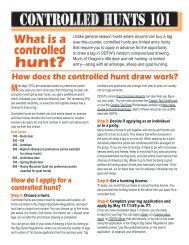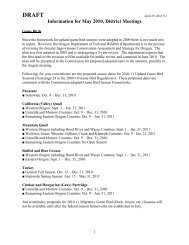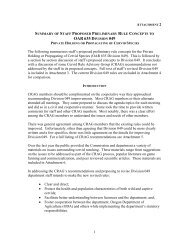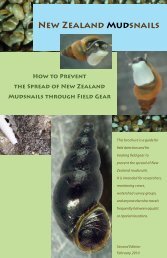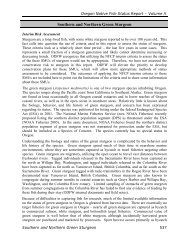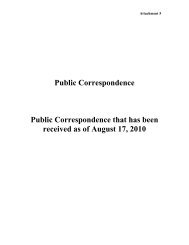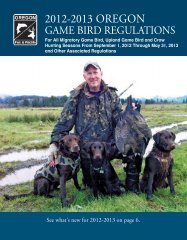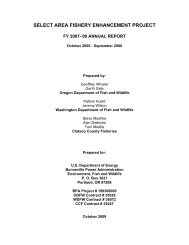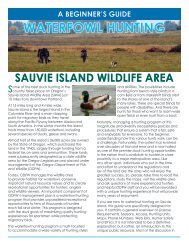Nutritional Condition Models for Elk - Oregon Department of Fish ...
Nutritional Condition Models for Elk - Oregon Department of Fish ...
Nutritional Condition Models for Elk - Oregon Department of Fish ...
Create successful ePaper yourself
Turn your PDF publications into a flip-book with our unique Google optimized e-Paper software.
<strong>Nutritional</strong> <strong>Condition</strong> <strong>Models</strong> <strong>for</strong> <strong>Elk</strong>: Which Are the Most Sensitive, Accurate, and Precise?<br />
Author(s): Rachel C. Cook, John G. Cook, Dennis L. Murray, Peter Zager, Bruce K. Johnson<br />
and Michael W. Gratson<br />
Reviewed work(s):<br />
Source: The Journal <strong>of</strong> Wildlife Management, Vol. 65, No. 4 (Oct., 2001), pp. 988-997<br />
Published by: Allen Press<br />
Stable URL: http://www.jstor.org/stable/3803047 .<br />
Accessed: 20/07/2012 14:56<br />
Your use <strong>of</strong> the JSTOR archive indicates your acceptance <strong>of</strong> the Terms & <strong>Condition</strong>s <strong>of</strong> Use, available at .<br />
http://www.jstor.org/page/info/about/policies/terms.jsp<br />
.<br />
JSTOR is a not-<strong>for</strong>-pr<strong>of</strong>it service that helps scholars, researchers, and students discover, use, and build upon a wide range <strong>of</strong><br />
content in a trusted digital archive. We use in<strong>for</strong>mation technology and tools to increase productivity and facilitate new <strong>for</strong>ms<br />
<strong>of</strong> scholarship. For more in<strong>for</strong>mation about JSTOR, please contact support@jstor.org.<br />
.<br />
http://www.jstor.org<br />
Allen Press is collaborating with JSTOR to digitize, preserve and extend access to The Journal <strong>of</strong> Wildlife<br />
Management.
NUTRITIONAL CONDITION MODELS FOR ELK: WHICH ARE THE<br />
MOST SENSITIVE, ACCURATE, AND PRECISE?<br />
RACHEL C. COOK,, 2 <strong>Department</strong> <strong>of</strong> <strong>Fish</strong> and Wildlife Resources, University <strong>of</strong> Idaho, Moscow, ID 83844, USA<br />
JOHN G. COOK, National Council <strong>for</strong> Air and Stream Improvement, 1401 Gekeler Lane, La Grande, OR 97850, USA<br />
DENNIS L. MURRAY, <strong>Department</strong> <strong>of</strong> <strong>Fish</strong> and Wildlife Resources, University <strong>of</strong> Idaho, Moscow, ID 83844, USA<br />
PETER ZAGER, Idaho <strong>Department</strong> <strong>of</strong> <strong>Fish</strong> and Game, 1540 Warner Avenue, Lewiston, ID 83501, USA<br />
BRUCE K. JOHNSON, <strong>Oregon</strong> <strong>Department</strong> <strong>of</strong> <strong>Fish</strong> and Wildlife, 1401 Gekeler Lane, La Grande, OR 97850, USA<br />
MICHAEL W. GRATSON,3 Idaho <strong>Department</strong> <strong>of</strong> <strong>Fish</strong> and Game, 1540 Warner Avenue, Lewiston, ID 83501, USA<br />
Abstract: Traditionally, biologists have developed indices that assess nutrition and condition <strong>of</strong> wild ungulates.<br />
However, many attempts to validate such indices have failed to indicate the range <strong>of</strong> conditions under which they<br />
work. Furthermore, such validation tests <strong>of</strong>ten fail to identify sensitivity to small but biologically meaningful dif-<br />
ferences, and emphasize statistical rather than biological relationships. We evaluated 20 models that were devel-<br />
oped to assess nutritional condition <strong>of</strong> Rocky Mountain elk (Cervus elaphus nelsonii). We analyzed sensitivity, bias,<br />
accuracy, precision, applicability across a wide range <strong>of</strong> body conditions, and field practicality. Because models<br />
were derived using captive elk, we incorporated data from 6 wild cows to assess suitability <strong>of</strong> condition-index mod-<br />
els <strong>for</strong> free-ranging elk. We found that most condition indicators available to biologists were weakly related to actu-<br />
al nutritional condition, were insensitive to small changes in condition, or <strong>of</strong>ten showed nonlinear relations that<br />
restricted their value to a narrow range <strong>of</strong> body condition. An arithmetic combination <strong>of</strong> a rump body-condition<br />
score and subcutaneous rump-fat thickness <strong>for</strong> live animals, and a modified carcass-evaluation score <strong>for</strong> dead ani-<br />
mals, were the most sensitive and accurate indices <strong>of</strong> nutritional condition that we tested.<br />
Key words: Cervus elaphus, condition indices, elk, fat index, nutrition, validation.<br />
Over the past several decades, researchers have<br />
developed many techniques to determine the<br />
nutritional condition <strong>of</strong> large ungulates. The<br />
most rigorous <strong>of</strong> such attempts involved measur-<br />
ing various indices <strong>of</strong> condition, homogenizing<br />
the carcass, and chemically analyzing it to determine<br />
fat, protein, water, and ash content. Statistical<br />
analysis <strong>of</strong> indices generally involved correlation<br />
between the indices and a body<br />
component, usually ingesta-free body fat. Nonlinear<br />
relationships <strong>of</strong>ten were trans<strong>for</strong>med to<br />
facilitate analysis using general linear models<br />
(e.g., Finger et al. 1981, Watkins et al. 1991, Cook<br />
et al. 2001). The value <strong>of</strong> indices usually was<br />
determined via comparison <strong>of</strong> correlation coefficients<br />
or coefficients <strong>of</strong> determination. However,<br />
these methods <strong>of</strong> analysis <strong>of</strong>ten are incomplete,<br />
leaving unanswered questions related to reliability,<br />
sensitivity, and applicability<br />
across space and time.<br />
<strong>of</strong> such indices<br />
Many have referenced these assessment limitations<br />
(e.g., Robbins 1983, Hobbs 1987, Ceder-<br />
1 Present address: National Council <strong>for</strong> Air and<br />
Stream Improvement, Forestry and Range Sciences<br />
Lab, 1401 Gekeler Lane, La Grande, OR 97850, USA.<br />
2 E-mail: rcook@eou.edu<br />
3 Deceased.<br />
JOURNAL OF WILDLIFE MANAGEMENT 65(4):988-997<br />
988<br />
lund et al. 1989, Harder and Kirkpatrick 1994)<br />
and have <strong>of</strong>fered criteria that should be used to<br />
evaluate the value <strong>of</strong> an index (Robbins 1983,<br />
Hobbs 1987). Useful indices <strong>of</strong> condition should<br />
(1) be linearly related to actual condition (i.e.,<br />
have a consistent relationship with nutritional<br />
condition over the entire range <strong>of</strong> the condition;<br />
Robbins 1983); (2) be insensitive to a variety <strong>of</strong><br />
confounding influences, such that specific relations<br />
developed <strong>for</strong> 1 area, time, or diet, are<br />
applicable to others without bias (Robbins 1983,<br />
Hobbs 1987); (3) share a biological relation<br />
rather than just a significant statistical correlation<br />
with condition (Robbins 1983); (4) exhibit low to<br />
moderate variation relative to the variation in the<br />
dependent variable (Hobbs 1987); and (5) be<br />
reasonably practical <strong>for</strong> field application.<br />
Our goal was to evaluate the sensitivity, bias,<br />
accuracy, precision, and applicability <strong>of</strong> a set <strong>of</strong><br />
nutritional condition models developed <strong>for</strong><br />
Rocky Mountain elk. These models were developed<br />
using regression analysis <strong>of</strong> 49 different<br />
indices (Cook et al. 2001). Because captive-raised<br />
elk cows were used, we also included 6 wild cows<br />
from northeast <strong>Oregon</strong> to assess potential nutritional<br />
condition differences resulting from freeranging<br />
versus captive existence. We present our<br />
recommendations <strong>for</strong> obtaining body condition
J. Wildl. Manage. 65(4):2001<br />
estimates <strong>for</strong> both live and dead elk based on the<br />
above criteria.<br />
METHODS<br />
We used 43 nongravid cow elk ranging from 1.5<br />
to 7.5 years <strong>of</strong> age to develop nutritional condi-<br />
tion models <strong>for</strong> cow elk (Cook et al. 2001). We<br />
grouped cows into 3 age classes (yearlings, 2 year<br />
olds, and adults) and 3 seasonal periods (Sep,<br />
Dec, and Mar) to evaluate effects <strong>of</strong> age and sea-<br />
son on the per<strong>for</strong>mance <strong>of</strong> each condition index.<br />
Within each season and age class, cows were<br />
VERACITY OF ELK CONDITION MODELS * Cook et al. 989<br />
kidney fat index-full (kidney fat index derived<br />
using the entire perirenal fat mass); (15) kidney<br />
fat index-trimmed (traditional kidney fat index<br />
using the trimmed perirenal fat mass); (16)<br />
femur marrow fat; (17) an arithmetic combination<br />
<strong>of</strong> kidney fat index-full and femur marrow<br />
fat (CONINDEX); (18) mandible marrow fat;<br />
(19) LIVINDEX + scapula muscle thickness +<br />
longissimus dorsi (loin) thickness; and (20) kidney<br />
fat mass + Wyoming index.<br />
Statistical Analysis<br />
Our evaluation consisted <strong>of</strong> 4 types <strong>of</strong> analyses<br />
reflecting criteria <strong>of</strong> Robbins (1983) and Hobbs<br />
(1987). We used (1) a range <strong>of</strong> usefulness evalu-<br />
placed on 1 <strong>of</strong> 3 nutritional regimes that provided<br />
a wide range <strong>of</strong> nutritional condition<br />
(1.6-19.0% ingesta-free body fat). Animals were<br />
euthanized and homogenized <strong>for</strong> total carcass<br />
fat, protein, ash, and water. Six wild cows captured<br />
from a herd in northeast <strong>Oregon</strong> in February<br />
1999 were similarly processed to determine<br />
body composition (Cook et al. 2001). We evaluated<br />
49 condition indices (including live-animal,<br />
dead-animal, and serum and urine indices) and<br />
developed predictive models <strong>of</strong> nutritional condition<br />
using regression analysis. See Cook et al.<br />
(2001) <strong>for</strong> full description <strong>of</strong> methodology and a<br />
list and description <strong>of</strong> all indices evaluated.<br />
From these models generated by Cook et al.<br />
(2001), we evaluated all single-variable models<br />
that produced a coefficient <strong>of</strong> determination<br />
>0.70, as well as the live and dead animal multivariable<br />
models with greatest predictive power.<br />
<strong>Models</strong> evaluated were (1) body mass; (2) bodycondition<br />
score (a palpation technique using<br />
scores from the withers, ribs, and rump); (3)<br />
rump body-condition score (the rump portion <strong>of</strong><br />
the body-condition score); (4) maximum subcutaneous<br />
rump fat thickness (obtained using ultra-<br />
sonography); (5) an arithmetic combination <strong>of</strong><br />
the body-condition score and maximum subcutaneous<br />
rump fat thickness (LIVINDEX); (6) an<br />
arithmetic combination <strong>of</strong> the rump body-condition<br />
score and maximum subcutaneous rump-fat<br />
thickness (rLIVINDEX); (7) body-reserve index<br />
(body-condition score multiplied by body mass);<br />
(8) serum levels <strong>of</strong> insulin-like growth factor-i;<br />
(9) serum levels <strong>of</strong> thyroxine; (10) modified Kistner<br />
score (a visual assessment <strong>of</strong> fat in indicator<br />
depot sites: cardiac, omental, perirenal, and subcutaneous<br />
areas); (11) Kistner subset score<br />
(heart, pericardium, and kidney scores <strong>of</strong> the<br />
modified Kistner score); (12) Wyoming index<br />
(scoring based on the presence or absence <strong>of</strong><br />
subcutaneous fat at the withers, stifle, and rump);<br />
ation to identify types <strong>of</strong> relations between<br />
indices and body fat (i.e., identify biological<br />
(13) kidney fat mass (mass <strong>of</strong> perirenal fat); (14)<br />
rela-<br />
tions that provide insights <strong>for</strong> what levels <strong>of</strong> condition<br />
the models apply); (2) an analysis <strong>of</strong><br />
model sensitivity to test variation in the index relative<br />
to variation in the dependent variable; (3) a<br />
bias analysis to test whether indices were consistently<br />
over- or underestimating body condition <strong>of</strong><br />
wild elk; and (4) an accuracy analysis to test how<br />
close estimations <strong>of</strong> body condition came to the<br />
actual fat values <strong>of</strong> wild elk and a precision analysis<br />
that evaluated the spread <strong>of</strong> absolute deviations<br />
around the average deviation.<br />
Range <strong>of</strong> Usefulness<br />
Many indices evaluated by Cook et al. (2001)<br />
had nonlinear relations with body fat and thus<br />
were only useful over a restricted range <strong>of</strong> condition<br />
(Robbins 1983). To compare the range <strong>of</strong><br />
usefulness among indices, we graphed levels <strong>of</strong><br />
fat and gross energy (GE; Mcal/kg) with a depletion<br />
ratio (DR) <strong>of</strong> each index. We inserted percent<br />
fat and GE levels (y-values) into each singlevariable<br />
predictive equation <strong>for</strong> each index (see<br />
Table 1 <strong>for</strong> general equations) and solved <strong>for</strong> x,<br />
providing index values we refer to as "IN." DR<br />
was then calculated as:<br />
DR = (IN - LV) + (HI - LV), where<br />
IN = value <strong>of</strong> index <strong>for</strong> any given level <strong>of</strong> fat or<br />
GE;<br />
LV = value <strong>of</strong> index at lowest value <strong>of</strong> fat or GE<br />
in our dataset (1.5% fat; 1.40 Mcal/kg);<br />
HI = value <strong>of</strong> index at highest value <strong>of</strong> fat or GE<br />
in our dataset (19% fat; 2.75 Mcal/kg).<br />
This equation standardized the depletion ratios<br />
across indices, with 1 being the highest value<br />
attained <strong>for</strong> that particular index <strong>for</strong> the range <strong>of</strong><br />
condition found in this study (no depletion) and
990 VERACITY OF ELK CONDITION MODELS * Cook et al. J. Wildl. Manage. 65(4):2001<br />
0 being the lowest value attained <strong>for</strong> that index<br />
(complete depletion). Differences in depletion<br />
patterns among indices were then compared<br />
graphically. Steep slopes represented hypersensitivity<br />
(i.e., large changes in the index relative to<br />
small changes in condition); shallow slopes represented<br />
hyposensitivity (i.e., small changes in the<br />
index relative to large changes in condition); and<br />
a slope <strong>of</strong> 0 indicated no predictive capability.<br />
Model Sensitivity<br />
We compared variation associated with the<br />
indices relative to variation in the dependent<br />
variable (% fat) <strong>for</strong> this set <strong>of</strong> models. We wanted<br />
to determine whether a seemingly good predic-<br />
tive model generated from data with a large range<br />
<strong>of</strong> condition (e.g., among seasons) could accu-<br />
rately assess condition within smaller ranges typi-<br />
cally found within seasons (see Hobbs 1987). We<br />
estimated within-season range <strong>of</strong> fat levels <strong>of</strong> wild<br />
elk to be 7 percentage points from condition data<br />
collected during early November (1998, 1999)<br />
and late March (1998, 1999) from an elk herd in<br />
the Cascade Mountains, near Enumclaw, Wash-<br />
ington, USA. We randomly selected 26 subsets<br />
from our captive elk data, each with a 7 percent-<br />
age-point range <strong>of</strong> body fat, and regressed % fat<br />
on the index <strong>for</strong> each subset <strong>of</strong> data. Model per-<br />
<strong>for</strong>mance was based on the average coefficient <strong>of</strong><br />
determination <strong>of</strong> the 26 regressions and the per-<br />
centage <strong>of</strong> them that were significant (P ? 0.05).<br />
Bias, Accuracy, and Precision<br />
We used the independent dataset from the 6<br />
wild elk captured in northeast <strong>Oregon</strong> to assess<br />
the 20 predictive models developed from the cap-<br />
tive elk data. We compared observed fat levels <strong>of</strong><br />
the wild elk to those predicted using the captive<br />
elk equations. We graphed the mean and 95%<br />
confidence intervals <strong>of</strong> the residuals (observed -<br />
predicted) <strong>for</strong> each <strong>of</strong> the 20 models <strong>for</strong> the wild<br />
elk. We also did this <strong>for</strong> all captive elk that fell<br />
into the same range <strong>of</strong> condition as the wild elk<br />
(
J. Wildl. Manage. 65(4):2001<br />
VERACITY OF ELK CONDITION MODELS * Cook et al. 991<br />
Table 1. Classification <strong>of</strong> selected condition indices into 5 curve types <strong>of</strong> relations between each condition index and total body<br />
fat. These general equations were used to develop the depletion ratio patterns depicted in Fig. 1.<br />
Type General equationa Indices<br />
Almost asymptotic-used linear regression<br />
<strong>for</strong> part <strong>of</strong> the data, the remainder was<br />
deemed a vertical line<br />
Femur marrow fat<br />
II y= abx Mandibular marrow fat<br />
Ill y= bx+ a Body-condition scores (whole and rump), LIVINDEX, rLIVINDEX,<br />
CONINDEX, modified Kistner score, Kistner subset score (heart,<br />
pericardium, and kidneys), body-reserve index, body mass, thyroxin<br />
IV y = a(1 - e-bX) All 3 kidney fat indices (full, trimmed, fat mass only), insulin-like growth<br />
factor-1<br />
V y = bx + a (with truncated range) Subcutaneous maximum rump fat thickness, modified Wyoming index<br />
a y = ingesta-free body fat (%); x = condition index values.<br />
levels <strong>of</strong> condition and hyposensitivity over high<br />
levels <strong>of</strong> condition (Fig. 1). Mandibular fat was<br />
our only example <strong>of</strong> this pattern and was most<br />
useful between approximately 5% and 13% body<br />
fat. Type III was derived from a linear relation<br />
(Table 1). It indicated a consistent relationship<br />
with body condition across the entire range <strong>of</strong><br />
nutritional conditions and thus was the most useful.<br />
Nine indices exhibited a Type III pattern<br />
(Table 1). Type IV was derived from a logarithmic<br />
relation (Table 1). It indicated hyposensitivity<br />
at low levels <strong>of</strong> condition, hypersensitivity at<br />
high levels <strong>of</strong> condition, and lost predictive capability<br />
at some high level <strong>of</strong> condition (as determined<br />
by original equation coefficients; Fig. 1).<br />
The kidney fat indices and insulin-like growth<br />
factor-1 exhibited this pattern. The kidney fat<br />
indices are most useful between approximately<br />
6% and 13% body fat and lose predictive ability<br />
above 16% body fat. Type V was derived from a<br />
linear relation but with an abruptly truncated<br />
range <strong>of</strong> usefulness (Table 1). It indicated a consistent<br />
relationship with body condition at moderate<br />
to high levels <strong>of</strong> condition, but no predictive<br />
capability at low levels <strong>of</strong> condition (Fig. 1).<br />
Rump fat thickness and the Wyoming index<br />
exhibited this pattern; they showed a consistent<br />
relationship with body condition above 6% body<br />
fat, but no predictive ability below this point.<br />
Model Sensitivity<br />
Sensitivity assessments demonstrated additional<br />
differences among models (Fig. 2). When<br />
restricted to within-season ranges <strong>of</strong> condition,<br />
coefficients <strong>of</strong> determination generally were lower<br />
than <strong>for</strong> between-season ranges. Body-condition<br />
score (Model 2), rump body-condition score<br />
(Model 3), maximum subcutaneous rump fat<br />
(Model 4), LIVINDEX (Model 5), rLIVINDEX<br />
(Model 6), modified Kistner score (Model 10),<br />
Kistner subset score (Model 11), kidney fat mass<br />
(Model 13), and the 2 multivariable models<br />
LIVINDEX + scapula + loin (Model 19) and kidney<br />
fat mass + Wyoming index (Model 20) were<br />
0<br />
S<br />
100%<br />
100%<br />
06 100 % I100%<br />
f<br />
0.6<br />
100%<br />
100%<br />
0.4 -32%20%F<br />
88.100%810986%<br />
0.2<br />
100%<br />
1 2 3 4 5 6 7 8 9 10 11 12 13 14 15 16 17 18 19 20<br />
Total fat (%) models<br />
Fig. 2. Sensitivity <strong>of</strong> the 20 best elk condition models from<br />
Cook et al. (2001). Sensitivity was evaluated by subjecting<br />
each to 26 regressions within a restricted range <strong>of</strong> condition<br />
(7 percentage points <strong>of</strong> body fat representing within-season<br />
variation <strong>of</strong> condition <strong>of</strong> wild elk in western Washington, USA;<br />
unpublished data, n = 50). The average coefficient <strong>of</strong> determination<br />
(? SE) and the percentage <strong>of</strong> time the model was<br />
significant over the 7-point ranges are presented. <strong>Models</strong><br />
used were (1) body mass; (2) body-condition score; (3) rump<br />
body-condition score; (4) maximum subcutaneous rump fat<br />
thickness; (5) an arithmetic combination <strong>of</strong> body-condition<br />
score and maximum subcutaneous rump fat thickness<br />
(LIVINDEX); (6) an arithmetic combination <strong>of</strong> the rump bodycondition<br />
score and maximum subcutaneous rump fat thickness<br />
(rLIVINDEX); (7) body-reserve index; (8) insulin-like<br />
growth factor-1; (9) thyroxine; (10) modified Kistner score; (11)<br />
heart, pericardium, and kidney scores <strong>of</strong> the Kistner score<br />
(Kistner subset score); (12) Wyoming index; (13) kidney fat<br />
mass; (14) kidney fat index-full; (15) kidney fat index-trimmed;<br />
(16) femur marrow fat; (17) an arithmetic combination <strong>of</strong> kidney<br />
fat index-full and femur marrow fat (CONINDEX); (18)<br />
mandible marrow fat; (19) LIVINDEX + scapula + loin; and<br />
(20) kidney fat mass + Wyoming index.
992 VERACITY OF ELK CONDITION MODELS * Cook et al. J. Wildl. Manage. 65(4):2001<br />
3.0 72<br />
S.-<br />
ED...<br />
42.5 -6<br />
I 2.0 -<br />
etao-60<br />
)<br />
S1.5-... Water (%) GE (Mcalikg) NEO elk<br />
(<br />
0 5 10 15<br />
Total fat (%)<br />
70<br />
68<br />
64.<br />
6<br />
58 -<br />
56<br />
20<br />
Fig. 3. Relations <strong>of</strong> total body fat with total body water (Fat %<br />
= -1.234x + 87.973, r2 = 0.94) and total gross energy (Fat %<br />
= 10.034x - 12.062, r2 = 0.96) <strong>for</strong> 43 captive-raised cow elk<br />
(ingesta-free basis). White squares and gray squares represent<br />
body water and gross energy data, respectively, <strong>of</strong> 6 wild<br />
elk from northeastern <strong>Oregon</strong>, USA.<br />
significantly related to condition (P ? 0.05) <strong>for</strong><br />
>80% <strong>of</strong> the 26 data subsets. However, body mass<br />
(Model 1), body-reserve index (Model 7),<br />
insulin-like growth factor-1 (Model 8), thyroxine<br />
(Model 9), Wyoming index (Model 12), kidney<br />
fat index-full (Model 14), kidney fat indextrimmed<br />
(Model 15), femur marrow fat (Model<br />
16), and CONINDEX (Model 17) were significandy<br />
related to condition (P< 0.05) <strong>for</strong> 2.5 percentage points compared to<br />
tame elk. Bias was small or nonexistent <strong>for</strong><br />
LIVINDEX (Model 5), rLIVINDEX (Model 6),<br />
modified Kistner score (Model 10), and the Kistner<br />
subset score (Model 11), the Wyoming index<br />
(Model 12), kidney fat index-full (Model 14), kidney<br />
fat index-trimmed (Model 15), femur marrow<br />
fat (Model 16), and CONINDEX (Model 17).<br />
The accuracy and precision analysis (Fig. 4B)<br />
provided a similar perspective. Our data generally<br />
suggested slightly less accuracy <strong>for</strong> predicting<br />
condition <strong>of</strong> wild elk than captive elk, particularly<br />
<strong>for</strong> the body mass (Model 1), body-reserve<br />
index (Model 7), insulin-like growth factor-i<br />
(Model 8), thyroxine (Model 9), and kidney fat<br />
index-trimmed (Model 15) prediction models.<br />
Absolute differences between observed and predicted<br />
body fat <strong>of</strong> wild elk were, on average, >1.5<br />
percentage points higher than that <strong>of</strong> the captive<br />
elk. Otherwise, differences in the magnitude <strong>of</strong><br />
inaccuracy between wild and captive elk were relatively<br />
small compared with 95% confidence<br />
intervals <strong>of</strong> the means. Precision with respect to<br />
wild versus captive was lowest <strong>for</strong> body mass<br />
(Model 1), body-reserve index (Model 7), insulinlike<br />
growth factor-i (Model 8), and thyroxine<br />
(Model 6), and was greatest <strong>for</strong> LIVINDEX<br />
(Model 5), rLIVINDEX (Model 6), modified Kistner<br />
score (Model 10), Kistner subset score<br />
(Model 11), kidney fat index-full (Model 14),<br />
femur marrow fat (Model 16), CONINDEX<br />
(Model 17), and the kidney fat mass + modified<br />
Wyoming score 2-variable model (Model 20).<br />
DISCUSSION<br />
Few studies have explicitly assessed within-season<br />
reliability, range <strong>of</strong> usefulness, sensitivity,<br />
accuracy, and precision <strong>of</strong> nutritional condition<br />
indices. Such analyses provide more insight into<br />
the value <strong>of</strong> indices than simple comparisons <strong>of</strong><br />
correlation coefficients or coefficients <strong>of</strong> determination<br />
<strong>of</strong> linear or linearized models. Our
J. Wildl. Manage. 65(4):2001<br />
results indicate that <strong>for</strong> elk, condition indices<br />
with similar coefficients <strong>of</strong> determination vary in<br />
their range <strong>of</strong> usefulness, sensitivity, and preci-<br />
sion, and that some <strong>of</strong> the more commonly used<br />
indices have limited predictive capability.<br />
Range <strong>of</strong> Usefulness<br />
Range <strong>of</strong> usefulness generally is a function <strong>of</strong><br />
linearity <strong>of</strong> relations between indices and nutritional<br />
condition. Trans<strong>for</strong>ming such data to make<br />
Q.<br />
c 0<br />
0<br />
0<br />
n, - 10<br />
t o<br />
0a 8<br />
.0<br />
S<br />
-5<br />
SA0<br />
,,<br />
I<br />
VERACITY OF ELK CONDITION MODELS * Cook et al. 993<br />
ir , |<br />
them linear is a common approach that facilitates<br />
analysis with linear statistical models. However,<br />
this approach has been criticized. Attempting to<br />
produce good statistical fit via this approach<br />
masks important biological attributes <strong>of</strong> indices<br />
(Robbins 1983:222). Nonlinearity <strong>of</strong> many con-<br />
dition indices <strong>of</strong>ten results from sequential pat-<br />
terns <strong>of</strong> fat mobilization across various areas <strong>of</strong><br />
the body (Harder and Kirkpatrick 1994). As ani-<br />
mals decline in condition, fat mobilization is<br />
1 2 3 4 5 6 7 8 9 10 11 12 13 14 15 16 17 18 19 20<br />
i<br />
C<br />
?<br />
2 3 4 5 7 8 9 10 11 12 13 14 15 16 17 18 19 20<br />
Total body fat (%) models<br />
.-.-- NE <strong>Oregon</strong> Cows U Captive Cows<br />
Fig. 4. Bias, accuracy, and precision <strong>of</strong> the 20 best elk condition models from Cook et al. (2001). In A, the mean and 95% confidence<br />
intervals <strong>of</strong> the residuals (observed fat percentage points - predicted fat percentage points) are presented <strong>for</strong> northeast <strong>Oregon</strong><br />
wild elk and all captive elk in the same range <strong>of</strong> condition (
994 VERACITY OF ELK CONDITION MODELS * Cook et al. J. Wildl. Manage. 65(4):2001<br />
believed to occur in subcutaneous depots first,<br />
viscera including the kidneys next, and finally in<br />
the marrow (Cederlund et al. 1989). Indices<br />
based on a depot that remains unchanged over a<br />
wide range <strong>of</strong> body condition have the least value<br />
(Robbins 1983).<br />
The different type curves <strong>of</strong> Fig. 1 generally<br />
reflect this sequence <strong>of</strong> fat mobilization and, in<br />
turn, identify patterns <strong>of</strong> range <strong>of</strong> usefulness.<br />
Indices exhibiting Types I and II curves have little<br />
sensitivity at high levels <strong>of</strong> condition, and thus<br />
probably are <strong>of</strong> value only in winter and spring.<br />
Indices with Type V curves are marginally useful<br />
at low levels <strong>of</strong> condition and probably are <strong>of</strong><br />
value only in summer and autumn. Indices with<br />
Type IV curves are most valuable at moderate levels<br />
<strong>of</strong> condition, and so optimum season <strong>of</strong> use<br />
depends on fat characteristics <strong>of</strong> the herd.<br />
Indices that are linear across the entire range <strong>of</strong><br />
condition (Type III) greatly facilitate comparisons<br />
among herds, among seasons, and across<br />
time. Our data indicated that range <strong>of</strong> usefulness<br />
<strong>of</strong> indices based on only 1 fat depot will be limited<br />
to some extent, and that range <strong>of</strong> usefulness<br />
will be greatest <strong>for</strong> indices that include measurements<br />
<strong>of</strong> more than 1 fat depot or muscle (e.g.,<br />
LIVINDEX, rLIVINDEX, body condition scores,<br />
the modified Kistner score, and the Kistner subset<br />
score).<br />
to be deposited around the kidneys at high levels<br />
<strong>of</strong> condition at a proportionally higher rate than<br />
total body fat. Combining femur fat and kidney fat<br />
indices into the CONINDEX may correct <strong>for</strong> poor<br />
predictive ability <strong>of</strong> kidney fat at low levels <strong>of</strong> condition<br />
<strong>for</strong> deer (Connolly 1981), but this index<br />
failed to predict with any accuracy<br />
Femur fat was the most nonlinear index we<br />
assessed. It varied in relation to condition only<br />
when body fat was below 6% (Cook et al. 2001).<br />
However, when linearized with a trans<strong>for</strong>mation,<br />
femur fat had 1 <strong>of</strong> the highest correlations with<br />
at higher levels<br />
<strong>of</strong> body condition <strong>of</strong> elk (Cook et al. 2001).<br />
The subcutaneous rump fat index covered the<br />
greatest range and the highest extreme in condition<br />
(6 to 19% body fat) <strong>of</strong> the fat deposit indices<br />
we examined, supporting the contention that the<br />
last depot <strong>of</strong> fat accretion is subcutaneous.<br />
Unlike the other fat indices, rump fat depth<br />
declines linearly as body fat decreases until it is<br />
depleted. As a result, range <strong>of</strong> usefulness was 2 to<br />
3 times greater than <strong>for</strong> the other fat indices.<br />
Nevertheless, value <strong>of</strong> this index may be limited<br />
during winter and spring.<br />
Model Sensitivity<br />
Hobbs (1987) pointed out that models found to<br />
be significant over a wide range <strong>of</strong> nutritional<br />
condition (e.g., among seasons) may not be significant<br />
over a smaller range <strong>of</strong> condition (e.g.,<br />
within seasons). Such models may be <strong>of</strong> value<br />
only to illustrate large differences. Our sensitivity<br />
analysis revealed that models with relatively<br />
small differences in coefficients <strong>of</strong> determination<br />
differed in their ability to predict across withinseason<br />
ranges <strong>of</strong> nutritional condition. In general,<br />
indices with moderate relations to body fat<br />
(e.g., body mass, body-reserve index, thyroxine),<br />
curvilinear relations (e.g., kidney fat indices,<br />
femur marrow fat, and insulin-like growth factor-<br />
1), or indices based on a relatively small number<br />
<strong>of</strong> categories (e.g., Wyoming index) provided<br />
poor predictive capability when restricted in this<br />
manner.<br />
body fat <strong>of</strong> any index we assessed, illustrating<br />
vividly the danger <strong>of</strong> trans<strong>for</strong>mations to enhance<br />
statistical relations (Cook et al. 2001). Mandible<br />
fat has been <strong>of</strong>fered as an easy-to-collect alterna-<br />
tive to femur fat collection (Harder and Kirk-<br />
patrick 1994). Although mandible fat appears<br />
somewhat more linear (suggesting a greater<br />
range <strong>of</strong> usefulness) significant age effects and<br />
lower correlations (Cook et al. 2001) cast doubt<br />
about its value <strong>for</strong> elk.<br />
Kidney fat indices have a long history <strong>of</strong> use in<br />
elk studies (e.g., Trainer 1971, Kohlmann 1999)<br />
despite a well-recognized nonlinear relation to<br />
body fat (e.g., Finger et al. 1981, Depperschmidt<br />
et al. 1987). Problems with prediction typically<br />
were believed to be mostly at the low end <strong>of</strong> con-<br />
dition (Harder and Kirkpatrick 1994). However,<br />
our data indicate that kidney fat indices also are <strong>of</strong><br />
marginal value above moderate levels <strong>of</strong> condition<br />
(>13% body fat) because fat probably continues<br />
Bias, Accuracy,<br />
and Precision<br />
Because most models tended to slightly overes-<br />
timate condition <strong>of</strong> both wild and captive elk<br />
(Fig. 4A), we conclude these indications <strong>of</strong> bias<br />
<strong>for</strong> wild elk are not necessarily a function <strong>of</strong> wild<br />
versus free-ranging existence. Rather, the ten-<br />
dency probably is a general bias that occurs at low<br />
levels <strong>of</strong> condition (
J. Wildl. Manage. 65(4):2001<br />
body-reserve index, insulin-like growth factor-i,<br />
and thyroxine.<br />
Overestimating condition <strong>of</strong> the wild elk using<br />
the body-mass and body-reserve indices, the latter<br />
a function <strong>of</strong> body mass, indicates they tended to<br />
be heavier than would be expected <strong>for</strong> their level<br />
<strong>of</strong> condition, compared to our captive elk. These<br />
results simply rein<strong>for</strong>ce that animals with<br />
markedly different body mass can have similar<br />
body composition due to a variety <strong>of</strong> factors (Torbit<br />
et al. 1985, Cook et al. 2001).<br />
Both serum models showed a strong bias: thyroxine<br />
overestimated condition whereas insulinlike<br />
growth factor-1 underestimated condition.<br />
Many factors may confound the relation <strong>of</strong> these<br />
hormones with body condition. Short-term nutrition,<br />
<strong>for</strong> example, is correlated to both insulinlike<br />
growth factor-i (McGuire et al. 1992, Webster<br />
et al. 1996) and thyroxine (Ryg and Jacobsen<br />
1982, Hamr and Bubenik 1990). The wild elk<br />
were held in a small paddock near the handling<br />
facilities <strong>for</strong> 1-2 days be<strong>for</strong>e processing, but consumption<br />
was not recorded, so we know nothing<br />
about their prior nutrition. Stage <strong>of</strong> production<br />
(e.g., 4 <strong>of</strong> the 6 wild elk were pregnant) also can<br />
influence insulin-like growth factor-i (Gluckman<br />
et al. 1987), but we would predict an overestimation<br />
bias instead, if this was the explanation. Nevertheless,<br />
our results suggest both serum indices<br />
are excessively influenced by confounding factors<br />
and should not be used <strong>for</strong> assessing body condition<br />
in wild elk.<br />
Our accuracy and precision analysis (Fig. 4B)<br />
suggested that models tended to have less predictive<br />
accuracy <strong>for</strong> wild elk than captive elk.<br />
However, such differences were small (
996 VERACITY OF ELK CONDITION MODELS * Cook et al. J. Wildl. Manage. 65(4):2001<br />
ness requires measurements using ultrasonography.<br />
Our ultrasonograph weighs 10 kg, fits into a<br />
backpack, and can be powered using small 12-volt<br />
batteries. Thus, it is sufficiently portable <strong>for</strong> field<br />
use even in rugged terrain. Ultrasonographs are<br />
expensive, however, and users require training.<br />
In addition, maximum subcutaneous rump fat<br />
thickness alone may be <strong>of</strong> little value <strong>for</strong> midwinter<br />
through spring evaluations in many elk herds<br />
if substantial portions <strong>of</strong> elk in wild herds have<br />
less than 6% body fat at this time (our experience<br />
indicates this situation predominates in the<br />
northwestern United States). The body-condition<br />
score (full or only the rump score) requires<br />
no equipment but does require modest training<br />
to use and the technque tends to be more subjective<br />
than ultrasound.<br />
MANAGEMENT IMPLICATIONS<br />
Declines in productivity and population numbers<br />
in elk herds, a phenomenon that is becoming<br />
increasingly severe and widespread in the<br />
Northwest (Irwin et al. 1994, Gratson and Zager<br />
1999), demand a better understanding <strong>of</strong> how<br />
nutrition influences elk populations. This requires<br />
condition indices <strong>for</strong> elk that are comparable<br />
across seasons and years. Variations in <strong>for</strong>age<br />
quantity, <strong>for</strong>age quality, winter severity, and<br />
summer drought, <strong>for</strong> example, can be related to<br />
changes in individual body condition and subsequently<br />
individual and population productivity.<br />
However, we found that most condition indicators<br />
available to biologists were not strongly related<br />
to actual nutritional condition (Cook et al.<br />
2001). These condition indicators <strong>of</strong>ten showed<br />
nonlinear relations and were insensitive to small<br />
changes in condition.<br />
For assessing nutritional condition <strong>of</strong> dead elk,<br />
if biologists have access to the entire carcass, we<br />
recommend the modified Kistner score or the<br />
Kistner subset score using only the heart, pericardium,<br />
and kidneys. If managers must rely on<br />
hunters to obtain samples, then we recommend<br />
using the Kistner subset score, a combination <strong>of</strong><br />
kidney fat mass and the modified Wyoming<br />
index, or the CONINDEX, with the caveat that<br />
interpretations <strong>of</strong> CONINDEX should reflect<br />
limitations <strong>of</strong> both marrow fat and kidney fat<br />
data. For predator-killed elk, we recommend<br />
scoring based on s<strong>of</strong>t tissues, if available. If adequate<br />
s<strong>of</strong>t tissue is unavailable, we recommend<br />
using femur rather than mandible fat, again with<br />
due consideration <strong>of</strong> its limitations (see Cook et<br />
al. 2001).<br />
For assessing nutritional condition <strong>of</strong> live elk,<br />
serum and urine indices are unsuitable. Instead,<br />
we recommend using either the rump body-con-<br />
dition score or the rLIVINDEX. These indices<br />
<strong>of</strong>fer the greatest accuracy and precision, are lin-<br />
ear, and cover the entire range <strong>of</strong> nutritional con-<br />
ditions likely to be encountered with wild elk.<br />
Such models work reasonably well <strong>for</strong> within-sea-<br />
son evaluations. However, results <strong>of</strong> the bias<br />
analysis shows a tendency <strong>for</strong> these indices to<br />
overestimate fat at low levels <strong>of</strong> condition, and<br />
suggests that the slightly curvilinear <strong>for</strong>m <strong>of</strong><br />
rLIVINDEX presented by Cook et al. (2001) is<br />
the more biologically correct expression. Train-<br />
ing is required <strong>for</strong> both body-condition scoring<br />
and ultrasonography.<br />
Un<strong>for</strong>tunately, the better techniques that we<br />
evaluated require animals or carcasses in hand.<br />
Technology to reliably assess nutritional condi-<br />
tion based on feces or urine apparently does not<br />
yet exist. However, we concur with Hobbs (1987)<br />
that the necessity <strong>of</strong> reliability should always pre-<br />
cede the need <strong>for</strong> applicability because unreli-<br />
able predictions can be misleading no matter<br />
how easily obtained.<br />
ACKNOWLEDGMENTS<br />
Financial support <strong>for</strong> this study was provided by<br />
Idaho <strong>Department</strong> <strong>of</strong> <strong>Fish</strong> and Game and Rocky<br />
Mountain <strong>Elk</strong> Foundation. Support <strong>of</strong> the elk<br />
herd was provided by the Northwest Forestry<br />
Association, Boise Cascade Corporation, National<br />
Council <strong>for</strong> Air and Stream Improvement, U.S.<br />
Forest Service Pacific Northwest Forest and Range<br />
Experiment Station, <strong>Oregon</strong> <strong>Department</strong> <strong>of</strong> <strong>Fish</strong><br />
and Wildlife, and Rocky Mountain <strong>Elk</strong> Foundation.<br />
This support was facilitated by L. L. Irwin, L. D.<br />
Bryant, R. A. Riggs, and J. G. Kie. We acknowledge<br />
the <strong>for</strong>esight and work <strong>of</strong>J. W. Thomas that<br />
established the infrastructure that supported this<br />
study. We thank the University <strong>of</strong> Idaho <strong>for</strong> logistical<br />
support; the U.S. Forest Service <strong>for</strong> supplying<br />
the ultrasonograph; B. L. Dick, J. C. Nothwang,<br />
R. O. Kennedy <strong>of</strong> the U.S. Forest Service,<br />
and D. Borum <strong>of</strong> <strong>Oregon</strong> <strong>Department</strong> <strong>of</strong> <strong>Fish</strong> and<br />
Wildlife <strong>for</strong> transporting the elk; R. L. Greene <strong>of</strong><br />
the <strong>Oregon</strong> <strong>Department</strong> <strong>of</strong> <strong>Fish</strong> and Wildlife <strong>for</strong><br />
logistical aid; B. Dixon <strong>of</strong> <strong>Oregon</strong> State University<br />
<strong>for</strong> allowing the use <strong>of</strong> the meat processing lab;<br />
and R. D. Sainz and T. Mori <strong>of</strong> the University <strong>of</strong><br />
Cali<strong>for</strong>nia (Davis) <strong>for</strong> use <strong>of</strong> the whole-body<br />
grinder and their slaughter facilities. T. R.<br />
Stephenson <strong>of</strong> the Alaska <strong>Department</strong> <strong>of</strong> <strong>Fish</strong> and<br />
Game provided ultrasonograph training; D. Vales
J. Wildl. Manage. 65(4):2001 VERACITY OF ELK CONDITION MODELS * Cook et al. 997<br />
and the Muckleshoot Indian Tribe, and L. C.<br />
Bender and R. Spencer <strong>of</strong> the Washington Depart-<br />
ment <strong>of</strong> <strong>Fish</strong> and Wildlife allowed use <strong>of</strong> Green<br />
River wild elk condition data. C. T. Robbins pro-<br />
vided the BIA machine and valuable guidance on<br />
methods in wildlife research. Pages 275-306 in T. A.<br />
Bookhout, editor. Research and management techniques<br />
<strong>for</strong> wildlife and habitats. Fifth edition. The<br />
Wildlife Society, Bethesda, Maryland, USA.<br />
HoBBs, N. T. 1987. Fecal indices to dietary quality: a cri-<br />
processing procedures. B. B. Davitt provided<br />
analysis <strong>of</strong> tissue composition and elk food. L. C.<br />
Bender reviewed the manuscript. We also thank<br />
T. E. George, N. Suverly, M. Alldredge, J. H.<br />
Noyes, and S. E. George <strong>for</strong> their assistance with<br />
handling and processing animals. This research<br />
was conducted in accordance with approved animal<br />
welfare protocol (Wisdom et al. 1993).<br />
LITERATURE CITED<br />
CEDERLUND, G. N., R. J. BERGSTROM, AND K. DANELLI.<br />
1989. Seasonal variation in mandible marrow fat in<br />
moose. Journal <strong>of</strong> Wildlife Management 53:587-592.<br />
CONNOLLY, G. E. 1981. Assessing populations. Pages<br />
287-345 in O. C. Wallmo, editor. Mule and blacktailed<br />
deer <strong>of</strong> North America. University <strong>of</strong> Nebraska<br />
Press, Lincoln, USA.<br />
COOK, R. C. 2000. Studies <strong>of</strong> body condition and reproductive<br />
physiology in Rocky Mountain elk. Thesis,<br />
University <strong>of</strong> Idaho, Moscow, USA.<br />
?-,J. G. COOK, D. L. MURRAY, P. ZAGER, B. K JOHNSON,<br />
AND M. W. GRATSON. 2001. Development <strong>of</strong> predictive<br />
models <strong>of</strong> nutritional condition <strong>for</strong> Rocky Moun-<br />
tain elk. Journal <strong>of</strong> Wildlife Management 65:973-987.<br />
DEPPERSCHMIDT, J. D., S. C. TORBIT, A. W. ALLDREDGE,<br />
AND R. D. DEBLINGER. 1987. Body condition indices<br />
<strong>for</strong> starved pronghorn. Journal <strong>of</strong> Wildlife Management<br />
51:675-678.<br />
FINGER, S. E., L. BRISBIN, JR., AND M. H. SMITH. 1981. Kidney<br />
fat as a predictor <strong>of</strong> body condition in white-tailed<br />
deer. Journal <strong>of</strong> Wildlife Management 45:964-968.<br />
GLUCKMAN, P. D., B. H. BREIER, AND S. R. DAVIS. 1987.<br />
Physiology <strong>of</strong> the somatotropic axis with particular<br />
reference to the ruminant. Journal <strong>of</strong> Dairy Science<br />
70:442-466.<br />
GRATSON, M. W., AND P. ZAGER. 1999. Study IV: factors<br />
influencing elk calf recruitment, Project W-160-R-25,<br />
Subproject 31. 1998 Progress report. Idaho <strong>Department</strong><br />
<strong>of</strong> <strong>Fish</strong> and Game, Lewiston, USA.<br />
HAMR, J., AND G. A. BUBENIK. 1990. Seasonal thyroid<br />
hormone levels <strong>of</strong> free-ranging white-tailed deer<br />
(Odocoileus virginianus) in tique. Journal <strong>of</strong> Wildlife Management 51:317-320.<br />
IRWIN, L. L., J. G. COOK, R. A. RIGGS, AND J. M. SKOVLIN.<br />
1994. Effects <strong>of</strong> long-term grazing by big game and<br />
livestock in the Blue Mountains <strong>for</strong>est ecosystems.<br />
U.S. Forest Service General Technical Report PNW-<br />
GTR-325. ,<br />
KISTNER, T. P., C. E. TRAINER, AND N. A. HARTMANN.<br />
1980. A field technique<br />
Ontario. CanadianJournal<br />
<strong>of</strong> Zoology 68:2174-2180.<br />
HARDER, J. D., AND R. L. KIRKPATRICK. 1994. Physiological<br />
<strong>for</strong> evaluating physical con-<br />
dition <strong>of</strong> deer. Wildlife Society Bulletin 8:11-17.<br />
KOHLMANN, S. G. 1999. Adaptive fetal sex allocation in<br />
elk: evidence and implications. Journal <strong>of</strong> Wildlife<br />
Management 63:1109-1117.<br />
McGUIRE, M. A., J. L. VICINI, D. E. BAUMAN, AND J. J.<br />
VEENHUIZEN. 1992. Insulin-like growth factors and<br />
binding proteins in ruminants and their nutritional<br />
regulation. Journal <strong>of</strong> Animal Science 70:2901-2910.<br />
ROBBINS, C. T. 1983. Wildlife feeding and nutrition.<br />
First edition. Academic Press, Orlando, Florida, USA.<br />
RYG, M., AND E. JACOBSEN. 1982. Seasonal changes in<br />
growth rate, feed intake, growth hormone, and thyroid<br />
hormones in young male reindeer (Rangifer tarandus<br />
tarandus). Canadian Journal <strong>of</strong> Zoology 60:15-23.<br />
TORBIT, S. C., L. H. CARPENTER, A. W. ALLDREDGE, AND<br />
D. M. Swirr. 1985. Mule deer body composition-a<br />
comparison <strong>of</strong> methods. Journal <strong>of</strong> Wildlife Management<br />
49:86-91.<br />
TRAINER, C. E. 1971. The relationship <strong>of</strong> physical condition<br />
and fertility <strong>of</strong> female Roosevelt elk (Cervus<br />
canadensis roosevelti) in <strong>Oregon</strong>. Thesis, <strong>Oregon</strong> State<br />
University, Corvallis, USA.<br />
WATKINS, B. E.,J. H. WITHAN, D. E. ULLREY, D.J. WATKINS,<br />
AND J. M. JONES. 1991. Body composition and condition<br />
evaluation <strong>of</strong> white-tailed deer fawns. Journal <strong>of</strong><br />
Wildlife Management 55:39-51.<br />
WEBSTER, J. R., I. D. CORSON, R. P. LITTLEJOHN, S. K. STU-<br />
ART, AND J. M. SUTTIE. 1996. Effects <strong>of</strong> season and<br />
nutrition on growth hormone and insulin-like growth<br />
factor-i in male red deer. Endocrinology 137:689-704.<br />
WISDOM, M. J., J. G. COOK, M. W. ROWLAND, AND J. H.<br />
NOYES. 1993. Protocols <strong>for</strong> care and handling <strong>of</strong> deer<br />
and elk at the Starkey Experimental Forest and<br />
Range. U.S. Forest Service General Technical Report<br />
PNW-GTR-311.<br />
Received 1July 2000.<br />
Accepted 1June 2001.<br />
Associate Editor: Krausman.



